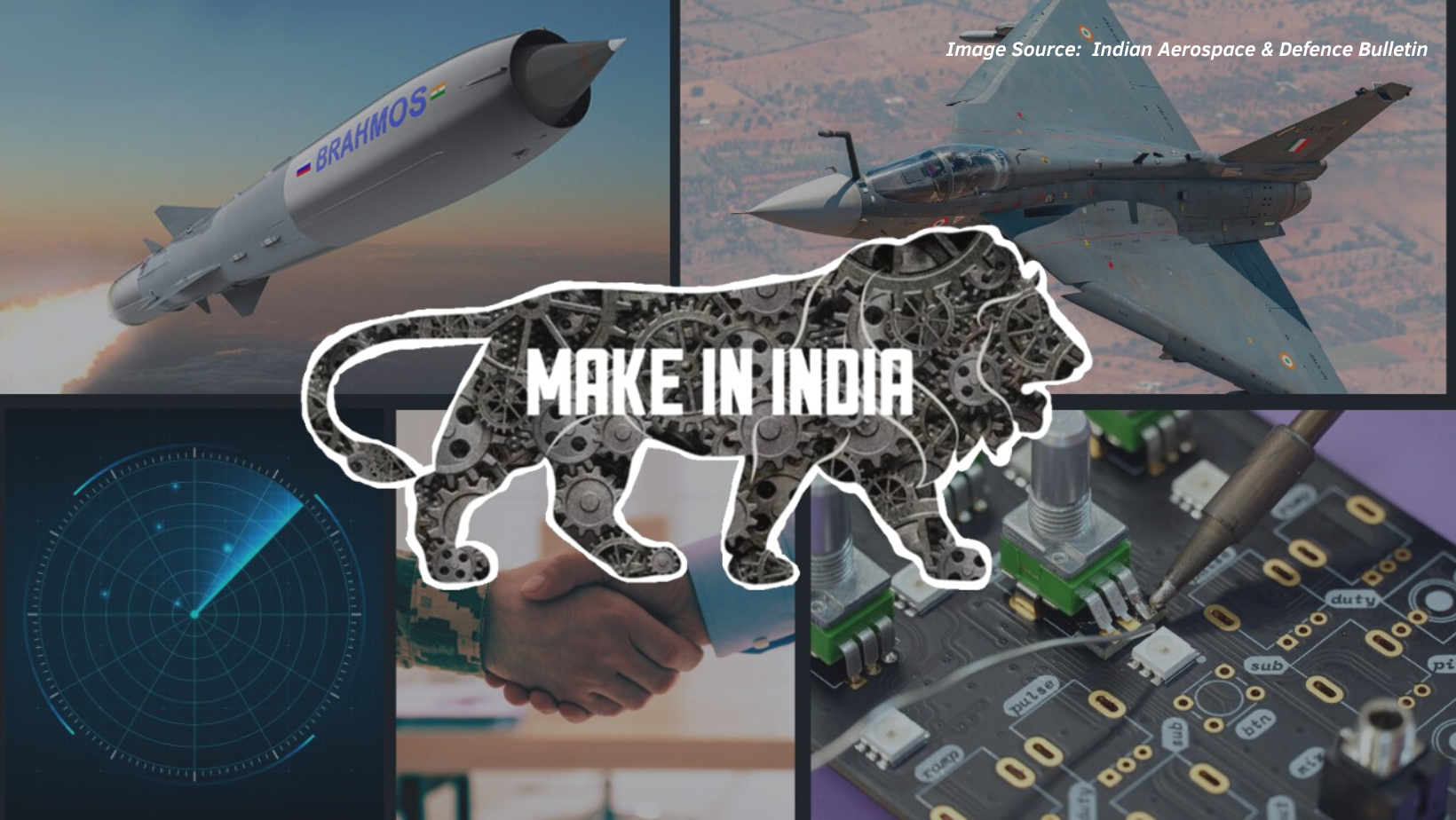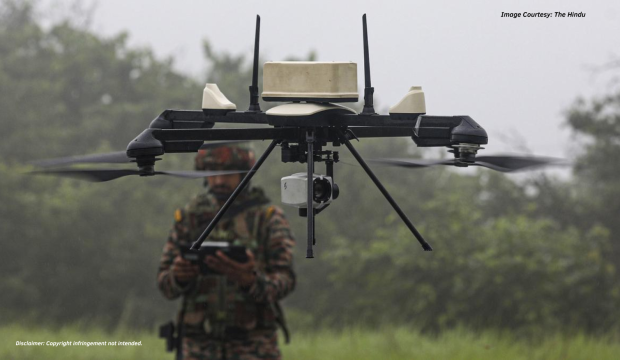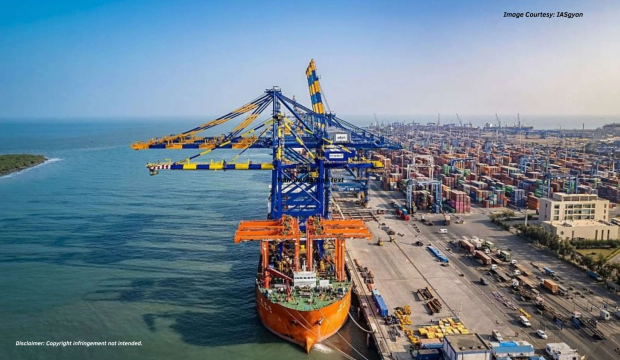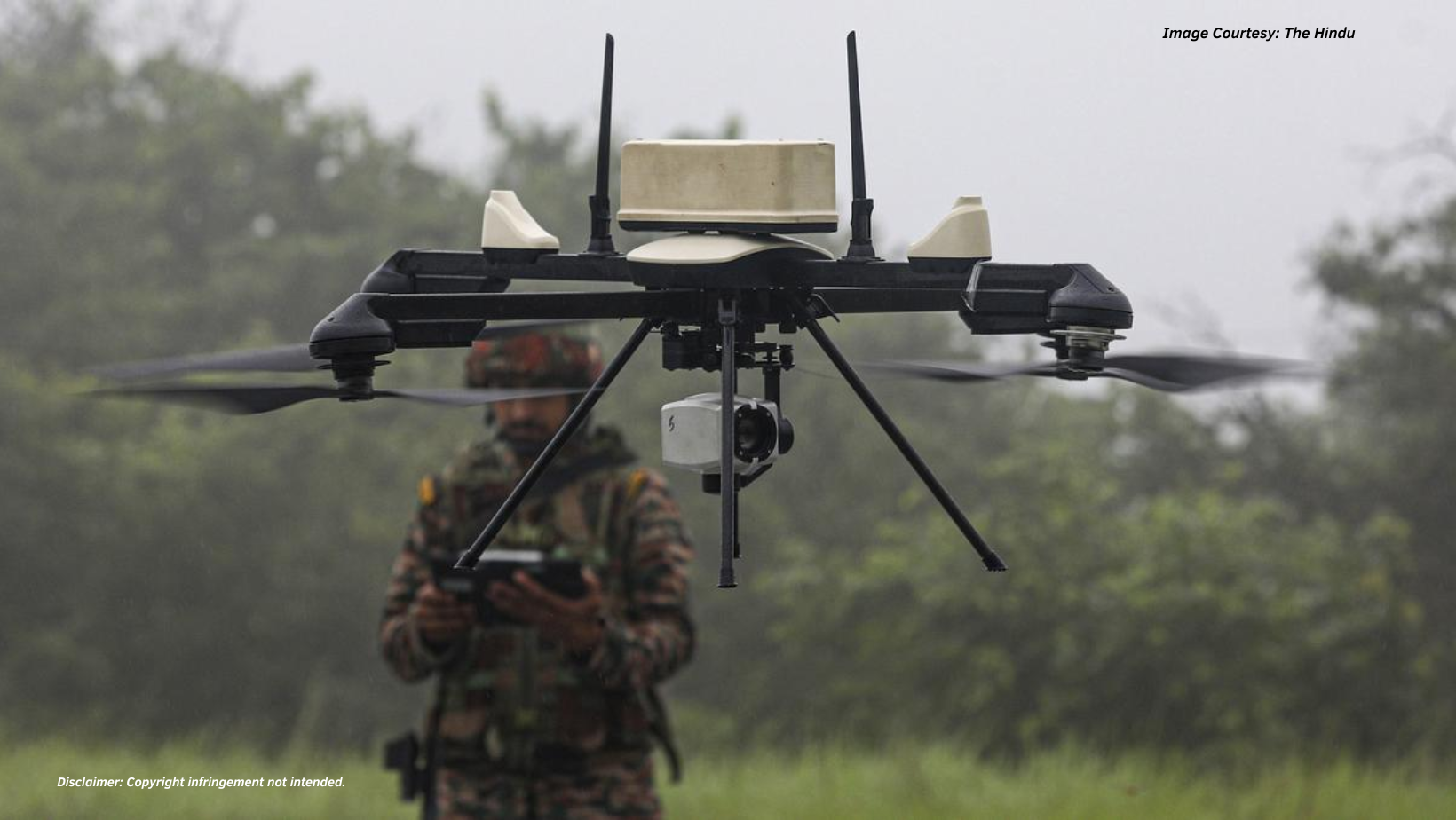“I want to tell the people of the whole world: Come, make in India. Come and manufacture in India. Go and sell in any country of the world, but manufacture here. We have skill, talent, discipline and the desire to do something. We want to give the world an opportunity that come make in India,”
Prime Minister of India, Mr Narendra Modi,
Maiden Independence Day speech on Aug 15, 2014
Data and Facts 1
- For the financial year 2023-24, India’s defence budget is set at INR 5.93 trillion, which is an increase from the INR 5.13 trillion allocated for FY 2022-23.
- India was the second ranked arms importer and constituted 9.5% of world arms imports between 2016 and 2020.
- The country’s defence exports have experienced significant growth, rising from INR 1,521 crore in 2016-17 to INR 15,980 crore in 2022-23.
- The public sector dominates the Indian defence industry, contributing 80% of the total production.
- As of August 1, 2022, India’s defence production for FY 2022-23 reached INR 17,885 crore (US$ 2.24 billion).
- Between April 2000 and June 2022, the defence sector received US$ 13.16 million in Foreign Direct Investment (FDI) equity inflow, as reported by DPIIT.
- In June 2022, the acquisition of military hardware from the domestic industries for a value worth US$ 9.84 billion (Rs 76,390 crore) has been approved.
- Under the Mission Raksha Gyan Shakti initiative, the Indian Patent Office granted or registered 1,474 Intellectual Property Rights (IPRs) as of September 30, 2022.
- 2022-2023 defence budget specified that 68% of capital procurement would be from domestic industry.
Existing Defence Industrial Base in India
The defence industrial base in India has been in existence since the 1940s, with the establishment of the Ordnance Factories (OFs). The IOFs were set up to meet the defence needs of the British Indian Army. After independence, the IOFs were nationalized and became the backbone of India’s defence production capabilities. In June 2021, the Cabinet Committee on Security (CCS) approved the transformation of the Ordnance Factories Board (OFB) into seven separate Defence Public Sector Undertakings (DPSUs). This decision was made to improve efficiency and stimulate growth and innovation within these Ordnance Factories.
However, existing defence industrial base in India comprising of DPSU and DRDO has several shortcomings, which have resulted in the country’s over-reliance on imports.
Shortcomings in Defence Industrial Base
One of the major shortcomings of defence industrial base has been the lack of private sector participation. The majority of defence production in India was being carried out by public sector undertakings (PSUs) and the IOFs (though IOFs have been corporatized in 2022). The private sector participation in defence production is restricted due to the complex licensing and regulatory procedures, lack of a level playing field, and limited access to technology.
Another major shortcoming of defence industrial base has been the lack of innovation and R&D capabilities. The Indian defence industry, largely dependent on foreign technology, has found it difficult to develop and produce cutting-edge technology indigenously.
Changes being Implemented
To address the shortcomings in the defence industrial base, several changes recommended by experts, are in the process of implementation. These include:
- Promoting private sector participation: Steps are being taken to increase participation of the private sector in manufacturing of defence equipment by simplifying the licensing and regulatory procedures, creating a level playing field, and providing access to technology. Since the opening up of defence sector for up to 100% participation by private sector in May 2001, 539 industrial licenses have been granted to 333 private entities, of which, 110 have commenced production activities .
- Encouraging innovation and R&D: A robust R&D ecosystem is being created for the defence industry, which would enable the development of cutting-edge technology indigenously. Twenty five percent (25 %) of the budget of R&D has been earmarked for Industry led R&D. In April 2018, Innovations for Defence Excellence (iDEX was introduced for creating an ecosystem for innovation in defence sector. Its purpose is to encourage technology development in the defence and allied sector with the participation of industries, innovators and academia.
- Fostering partnerships: The government is encouraging partnerships between Indian defence companies and foreign companies to transfer technology and expertise.
Self- Reliance Initiative
Atmanirbhar Bharat, which translates to “self-reliant India,” has been coined by Indian Prime Minister, Narendra Modi, to promote self-sufficiency in all sectors of the economy. One of the key areas where the government is focusing on achieving self-reliance is the defence sector. Indian spending on import of defence equipment are quite huge, and this has been a significant concern for the government due to the country’s geopolitical situation. India’s reliance on foreign nations for its defence equipment makes it vulnerable to supply chain disruptions and geopolitical pressures.
To address this issue, the Indian government has been taking measures to support self-reliance in the defence manufacturing. One of the primary strategies adopted is indigenisation, i.e. promoting domestic production of defence equipment. This strategy is aimed at reducing India’s dependence on imports and promoting the domestic defence industry.
India continues to remain in the strategic vulnerable space as its arms import accounts for 11% of the imports globally in the period 2018-22.
Indigenisation efforts in the defence sector have been accelerated in the ‘Make in India’ program. The initiative seeks to create a conducive environment for both domestic and foreign companies to manufacture locally. One of the key measures under the initiative has been the creation of exclusive zones for defence manufacturing. These zones, called Defence Industrial Corridors, are intended to serve as a hub for defence manufacturing and research in the country. Two corridors, namely the UP Defence Industrial Corridor (UPDIC) and Tamil Nadu Defence Industrial Corridor (TNDIC) have been created by the Indian Government.
The government has also taken steps to encourage private sector participation in the defence manufacturing sector. Earlier, the Indian defence sector was dominated by the public sector, but with the inclusion of private players, there has been a significant increase in the number of defence equipment manufacturers in the country. Private sector participation has also led to increased competition and innovation in the sector, leading to better quality products and reduced costs.
There has been an increase in share of domestic procurement in the country. The share of domestic procurement increased from 54% in 2018-19 to 59% in 2019-20. It further went up to 64% in 2020-21. In 21-22, the share has increased to 68% of which 25% is earmarked for purchase from private industries.
The inclusion of private players in the defence sector has also led to an increase in the number of jobs being created. The defence manufacturing sector is a labour-intensive industry, and the expansion of this sector has created numerous employment opportunities, particularly for skilled workers. According to a 2020 FICCI report, entry of private players in the defence sector has created significant job opportunities in India. The report states that the private sector has already created around 80,000 opportunities in the area of defence manufacturing, and this number is likely to increase in the future as more companies enter the market and the sector expands.This has been a significant boost for the Indian economy, particularly in the follow-up of the pandemic, which had caused widespread job losses.
Major Initiatives for Indigenisation of Defence Sector
The Government’s Atmanirbhar Bharat initiative has focused on India’s defence sector, which aims to promote indigenous production and reduce the country’s dependence on imports. The major initiatives for indigenisation of the country’s defence sector are:
Defence Production and Export Promotion Policy: The DPEPP is a major initiative launched by the government to promote indigenous production and exports in the defence sector. The policy aims to increase the domestic defence manufacturing base and reduce dependence on imports. The DPEPP plans to achieve the target of defence manufacturing of Rs 1.75 lakh crore by 2025.[2]
Under DPEPP, the government has identified four strategic areas of focus, including aerospace and defence components, defence manufacturing, defence R&D, and defence exports. The policy aims to provide incentives to promote indigenous production, including tax incentives and subsidies, and promote collaboration between Indian and foreign companies.
Technology Development Fund: The TDF is a major initiative launched by the government to promote indigenous production of latest systems in defence sector. This programme of MoD is being executed by DRDO and will meet the Tri-Services and Defence Production requirements. The fund aims to provide financial assistance to Indian companies to develop and manufacture defence equipment and systems. Under the TDF, the government provides financial assistance to Indian companies to develop critical defence technologies and products. The fund aims to promote collaboration between Indian and foreign companies and create a robust defence manufacturing ecosystem in the country.
Raksha Mantri Shri Rajnath Singh has enhanced the funding under TDF scheme to Rs 50 crore per project.[3]. As per latest updates, 163 Technologies are being Indigenised (Under R&D), Rs 249 Crores Funds have been Sanctioned with 5167 Companies on board[4].
‘Dare To Dream’ Scheme. The scheme promotes and supports innovations in Defence & Aerospace. Start-ups and innovators are provided an opportunity by DRDO for to solve some challenges in emerging areas of technology that can boost the capabilities of India’s defence & aerospace sector. Three Dare to dream seditions have been held and a total of 52 individuals and 34 start-ups have been awarded. [5]
Strategic Partnership Model: SPM is a major initiative of government to promote collaboration between Indian and foreign companies in defence sector. The SPM aims to promote joint ventures between Indian and foreign companies to manufacture defence equipment and systems in India.
Under the SPM, the government has identified four areas of focus, including fighter aircraft, helicopters, submarines, and armoured fighting vehicles. The SPM aims to provide incentives to promote joint ventures and provide a platform for technology transfer. A committee has been set up by the government to review and select private sector companies for the strategic partnership model. The OEM selection must be based on the price and technology transfer alone.[6]
Positive Indigenisation Lists[7]: The Indian government has formulated four Positive Indigenisation Lists (PILs) to promote indigenization in the defence sector. These lists consist of 101 items that the Indian armed forces require for their operational preparedness, which the domestic industry can manufacture. The first PIL was released in August 2020, followed by the second PIL in November 2020. The third PIL was released in February 2021, and the fourth PIL in April 2021. These lists provide a significant opportunity for the Indian industry to participate in production of defence equipment and contribute to the country’s indigenization efforts.
Liberalization of Foreign Direct Investment (FDI): To attract foreign investment in the defence sector and promote indigenization, the Indian government has liberalized its FDI policy. The Indian government has is encouraging FDI in the sector, with 100% FDI permitted under the automatic route in the defence manufacturing sector.[i] The government has also eased regulations and simplified procedures to attract foreign investors. The inclusion of FDI has not only provided a significant boost to the sector’s growth but also helped in the transfer of technology and knowledge. FDI figures for the defence sector: [9]
- April-September 2022: USD 3.21 million
- 2021-22: USD 2.36 million
- 2020-21: USD 0.63 million
- 2019-20: USD 2.20 million
- 2018-19: USD 2.18 million
- 2017-18: USD 0.01 million
Mission DefSpace[10]: In October 2022, the Indian government launched Mission DefSpace during DefExpo, to promote the indigenization of critical defence technologies, enhance national security, and make India self-reliant in the space domain. To get innovative solutions, 75 challenges have been opened, based on the space domain requirements of the defence sector. The mission aims to build capabilities in niche technology areas, enhance space-based communication, and strengthen the country’s space-based surveillance system. The initiative will also provide an impetus to the domestic industry, including MSMEs, to participate in defence production and contribute to the country’s indigenization efforts.
Defence Innovation Fund and Innovations for Defence Excellence (iDEX) scheme[11]: DIF and iDEX aim to engage Industries, startups, innovators, institutes and academia involved in research, by creating an ecosystem to enable technology development and foster innovation. The selected start-ups and innovators will be provided grants/funding, incubation facilities, access of the defence testing facilities to carry out R&D development potential for incorporation in the defence sector. The iDEX scheme was launched in April 2018. The scheme will contribute to the country’s indigenization efforts by creating a culture of innovation in the defence sector.
iDEX partners with Indian investor community to support and accelerate the growth of Defence Ecosystem. This is also aimed at giving investors a unified view of opportunities and innovations in Defence Sector. IDex Investors Hub (IIH) was launched by RM during the manthan at Aero-India 2023 to accelerate investment in Defence Sector with a pledged investment of 200 Cr from nine investors to augment the growth of startup ecosystem[12].
SRIJAN indigenization portal[13]: To facilitate indigenization the Indian government launched Department of Defence Production’s indigenization portal called SRIJAN in August 2020. The portal is a single-window interface that connects the industry with the defence establishment and provides them with information about the products that the defence establishment requires. The portal will also enable the industry to showcase their capabilities and provide them with a platform to participate in defence production and contribute to the country’s indigenization efforts. As per the Minister of State for Defence Ajay Bhat the SRIJAN portal has seen tremendous response, with the offering of over over 26 thousand defence items, uploaded on the portal, to the Industry for indigenisation”.[14]
Reforms in Offset policy[15]: The offset policy has been reformed to encourage foreign companies to invest in defence industries and promote transfer of technology. The policy mandates that foreign companies that win defence contracts in India should invest a minimum of 30% of the contract value in India’s defence sector. The investment can be made in areas such as research and development, defence production, and aerospace. The new policy also assigns higher multipliers for investments made in MSMEs, technology transfers, and exports. The reforms in the Offset policy are expected to provide a significant impetus to the country’s indigenization efforts.
Budget for Industry-led R&D: To encourage industry-led research and development, 25% of the R&D budget has been allocated for industry by the Government. The move is expected to encourage the domestic industry, including MSMEs, to invest in R&D and develop new technologies and products. The initiative will also provide the industry with the necessary financial support to undertake high-risk, high-reward R&D projects.
To promote indigenization in the defence sector, the Indian government has been progressively increasing the share of the defence budget for procurement from domestic industry. The government intends to achieve a domestic procurement share of 70% by 2025. The move is expected to provide a significant impetus to the domestic industry, including MSMEs, to participate in defence production and contribute to the country’s indigenization efforts.
Defence Industrial Corridors[16]: Such corridors have been identified in the country to promote indigenous production in the defence sector. The corridors are located in Tamil Nadu, Uttar Pradesh, Maharashtra, Gujarat, Karnataka, and Andhra Pradesh. The corridors aim to create a conducive environment for investment, develop infrastructure, and promote innovation and entrepreneurship in the area related to defence manufacturing.
The defence industrial corridors aim to promote collaboration between Indian and foreign companies and provide a platform for technology transfer. The corridors are expected to create job opportunities and boost the country’s economy.
Research and Development. One of the significant challenges faced by the Indian defence industry is the lack of a robust research and development (R&D) ecosystem. Most of the critical components used in defence equipment are still imported, and the domestic R&D infrastructure needs to be strengthened to reduce this dependence on imports. Currently, R&D expenditure constitutes around 6% of the country’s defence budget[17], which is lower compared to countries like the US (15%) and China (20%)[18]. Enhancing R&D investment in defence manufacturing is essential for India to remain competitive and create a robust defence ecosystem.
Collaboration with Higher Education Institutes. The country has several premier institutions such as the Defence Research and Development Organisation (DRDO) and the Indian Institutes of Technology (IITs), which have been instrumental in developing indigenous technologies for defence equipment. However, the industry needs to collaborate more with these institutions to leverage their expertise and resources to develop new technologies. The few existing collaborations with IITs include:
- ‘DRDO Industry Academia- Ramanujan Centre of Excellence’ (DIA-RCoE), between IIT Madras Centre of Excellence (CoE) and DRDO, has been set-up for focused research in areas of advanced technologies for defence and in the security sector[19];
- CoE in the field of Computational Fluid Dynamics (CFD) set up by Aeronautics Research & Development Board (AR & DB) at IISc, Bangalore as its hub center and the associate centres located at IIT, Kanpur and IIT Mumbai. The focus of the CoE is to bring provide the CFD community an opportunity to come together and create the required synergy for developing this technology.
- CoE in Aerospace Systems Design & Engineering setup by AR&DB at IIT, Mumbai.
- CoE for Composite Structures and Smart Applications sanctioned by AR&DB at NAL, Bangalore as its hub center and its associate centres being IISC, Bangalore, IIT, Kanpur and IIT, Kharagpur. The CoE has been created for activities relating to design & confirmation of composite structures, characterisation of required materials and the technique for analysing defects, life evaluation etc.[20]
- Directorate of Extramural Research & Intellectual Property Rights (DER&IPR)[i] is establishing Advance Technology Centres/CoE at premier Institutes and Universities for research in cutting edge technologies.
- IIT Jodhpur has set up DRDO-Industry-Academia Centre of Excellence[22].
Critical Technologies. Another area that needs attention is the development of critical and new technologies like artificial intelligence, unmanned systems, and cyber security. The defence sector is highly dependent on these technologies, and India needs to invest in developing indigenous technologies to improve the effectiveness of defence equipment, modernize its armed forces and enhance national security, and reduce its dependence on imports.
- Artificial Intelligence (AI): DRDO has established the Centre for Artificial Intelligence and Robotics (CAIR), focusing on AI applications in surveillance, reconnaissance, and decision-making.[23] As per the Department of Defence Production, 40 AI projects are complete as of April 30, 2022 and another 68 AI projects are planned until March 2024.
- Quantum Technologies: India has launched a National Mission on Quantum Technologies and Applications (NM-QTA) with an initial corpus of $1.12 billion to develop quantum communication, computing, and cryptography.[24]
- Cognitive Technologies: DRDO is researching cognitive technologies to improve human-machine interactions in complex defence systems, enhancing situational awareness and decision-making capabilities.[25]
- Stealth and Anti-Stealth Technologies: India is working on projects like the Advanced Medium Combat Aircraft (AMCA), incorporating stealth technology to evade enemy radar detection. Additionally, the DRDO is developing anti-stealth technology to counter adversaries’ stealth capabilities.[26]
- Robotics: DRDO’s Centre for Robotics and Unmanned Systems (CRUS) focuses on the development of ground and aerial robotic systems for various applications, including surveillance, search and rescue, and explosive ordnance disposal.[27]
Exports. The Indian defence industry also needs to focus on enhancing its export capabilities. The Raksha Mantri, Rajnath Singh, during the Commanders Conference at Bhopal on 01 Apr 2023 announced that the exports of arms and defence technologies was creating new records and had reached Rs 15920 cr in 2022–23, this was its maximum earnings till date, and a tenfold increase since 2016-17.[28] He also informed that, “India was now exporting to over 85 countries. Indian industry has shown its capability of design and development to the world, with 100 firms exporting defence products at present. The rising defence exports and participation of 104 countries in Aero India 2023 are proof of India’s growing defence manufacturing capabilities”.[29] Inspite of the above figures, currently, India is not a significant exporter of defence equipment, and efforts need to be made to develop indigenous technologies that can be exported to other countries.
Skilled Workforce. Another area that needs attention is the development of a skilled workforce. Skilling is crucial for achieving self-reliance in the development, production, and maintenance of advanced defence systems. The National Skill Development Corporation (NSDC) has identified aerospace and defence as priority sectors and launched initiatives to enhance workforce skills[30]. The Aerospace and Aviation Sector Skill Council (AASSC) aims to train around 600,000 personnel by 2035, addressing the skill gap in the defence industry[31]. The Defence Offset Policy also mandates the transfer of skills and technology to Indian companies, further strengthening the skilled workforce. Investing in skilling will enable India to develop a robust defence manufacturing ecosystem.[32]
Testing and Evaluation. The Indian defence industry also needs to focus on enhancing its testing and evaluation capabilities. A robust testing and evaluation infrastructure is essential to ensure that the equipment meets the required quality standards. The industry should invest in developing testing facilities and procedures that adhere to international standards. DRDO’s laboratories are equipped with cutting-edge infrastructure, including ‘Test Facilities’. Indian private industries involved in defence manufacturing, including those participating in the ‘Make in India’ initiative, can now access these ‘Test Facilities’ on a fee basis. This decision aims to support the growth of the domestic defence industry and encourage collaboration between the government and the private sector.[33]
Infrastructure and Logistics. Another area of concern is the quality of infrastructure and logistics support for the defence industry. Inadequate infrastructure, including transport and connectivity, can significantly impact the industry’s growth and development. The Indian government needs to invest in developing infrastructure, such as roads, railways, and ports, to provide efficient logistics support for the defence industry. There has been a investment of 2422 Cr in UPDIC and 3,861 crore in TNDIC (MoUs and infrastructure development).[34]
Conclusion
The indigenisation of India’s defence sector is a crucial priority for the country’s strategic and economic interests. Over the years, the government has taken various initiatives to reduce dependence on imports, boost domestic production, and promote self-reliance in defence sector. The recent Defence Acquisition Procedure, Defence Production and Export Promotion Policy, and Atmanirbhar Bharat Abhiyan are significant steps in this direction, aiming to create a favourable ecosystem for the growth of the defence sector.
The emphasis on research and development, technology transfer, and public-private partnerships has also provided a platform for innovation and collaboration between the public and private sectors. This approach has helped address the skill gaps and promote the development of indigenous technologies in the defence sector. It has also opened up opportunities for foreign companies to invest in India’s defence industry and partner with domestic firms to expand their business operations.
Despite the challenges in implementing these initiatives, including the need to improve the ease of doing business and the regulatory environment, the government’s commitment to indigenisation and self-reliance is expected to lead to significant growth in the Indian defence industry. In consonance with the changing geopolitical environment and the growing demand for advanced defence technologies, India has an opportunity to emerge as a global player in the defence industry. By leveraging its technological capabilities and innovative capacity, India can transform its defence industry and achieve strategic and economic self-sufficiency in the defence sector and achieve the target of spending $130 billion on military modernization by 2025[35] and increasing defence production to INR 180,0000 crore (USD25 billion) by 2025.
References
- “IBEF : Defence Manufacturing Industry in India- Recent Development/Investments”, https://www.ibef.org/industry/defence-manufacturing
- Defence Production and Export Promotion Policy 2020: https://www.mod.gov.in/sites/default/files/Defence%20Production%20and%20Export%20Promotion%20Policy%202020_0.pdf
- “Funding under Technology Development Fund scheme of DRDO enhanced to Rs 50 crore per project from Rs 10 crore”, https://www.pib.gov.in/PressReleasePage.aspx?PRID=1832042
“Technology Development Fund, DRDO”, https://tdf.drdo.gov.in/
Dare to Dream Scheme for promoting Start-ups”, 12 DeC 2022, https://pib.gov.in/PressReleasePage.aspx?PRID=1882706
“Implement strategic partnership policy successfully to boost make in India”, https://economictimes.indiatimes.com/news/defence/view-implement-strategic-partnership-policy-successfully-to-boost-make-in-india/articleshow/91842590.cms?from=mdr
- “4th Positive Indigenisation List”, https://mod.gov.in/sites/default/files/4th-PIL_comp.pdf
- “India Increases FDI Cap in Defence Sector to 100%.” Press Trust of India, The Economic Times, 4 February 2022, economictimes.indiatimes.com/news/economy/policy/india-increases-fdi-cap-in-defence-sector-to-100/articleshow/89463217.cms.
- https://economictimes.indiatimes.com/news/defence/india-receives-usd-3-21-mn-fdi-in-defence-industries-during-apr-sep-fy23/articleshow/96454017.cms
“Mission Defence Space: India’s Gateway to the Final Frontier.” Indian Space Research Organisation, 2021, www.isro.gov.in/missions/mission-defence-space.
“iDEX – Operationalization Plan for Defence Innovation Organization (DIO) & Defence Innovation Fund (DIF)”, https://idex.gov.in/sites/default/files/2020-10/iDEX-compendium.pdf
- “iDEX-Innovation for Defence Excellence”, https://idex.gov.in/#main-content-section
- “SRIJAN – Portal for Indigenisation in Defence Sector.” Ministry of Defence, Government of India, 2022, www.srijandefence.gov.in/.
- “Over 26,000 defence items uploaded on SRIJAN Portal and offered to Industry for indigenization”, 20 Mar 2023, https://newsonair.gov.in/News?title=Over-26%2C000-defence-items-uploaded-on-SRIJAN-Portal-and-offered-to-Industry-for-indigenisation&id=457866
- “Offset Policy.” Department of Defence Production, Ministry of Defence, Government of India, 2021, ddpdop.gov.in/offset-policy.
- “India to Set up Defence Manufacturing Clusters in 7 States.” PTI, The Economic Times, 30 March 2022, economictimes.indiatimes.com/news/economy/policy/india-to-set-up-defence-manufacturing-clusters-in-7-states/articleshow/90705428.cms.
- Laxman, K. (2020). India lags behind in defence R&D spending. The Hindu. Retrieved from https://www.thehindu.com/news/national/india-lags-behind-in-defence-rd-spending/article32462978.ece
- “International Institute for Strategic Studies (2020). The Military Balance 2020”. Retrieved from https://www.iiss.org/publications/the-military-balance
“IIT Madras Centre of Excellence working with DRDO on Advanced Defence Technologies including Combat Vehicle Technologies”, 02 Jan 2023, https://pib.gov.in/PressReleasePage.aspx?PRID=1887996
- AR & DB, DRDO, https://www.drdo.gov.in/aeronautics-research-development/centres-excellence
DER & IPR, DRDO, https://www.drdo.gov.in/adv-tech-center
“IIT Jodhpur and DRDO set up DRDO-Industry-Academia Centre of Excellence”, 21 Oct 2022, https://www.hindustantimes.com/education/news/iit-jodhpur-and-drdo-set-up-drdo-industry-academia-centre-of-excellence-101666344003540.html
“Centre for Artificial Intelligence and Robotics (2021). DRDO Labs & Establishments”. Retrieved from https://www.drdo.gov.in/labs-establishment/centre-artificial-intelligence-robotics-cair
- “Department of Science and Technology, Government of India (2020). National Mission on Quantum Technologies & Applications”. Retrieved from https://dst.gov.in/national-mission-quantum-technologies-applications
- “Defence Research and Development Organisation (2021). Cognitive Technology”. Retrieved from https://www.drdo.gov.in/cognitive-technology
“Aeronautical Development Agency, Ministry of Defence (2021). Advanced Medium Combat Aircraft (AMCA)”. Retrieved from https://www.ada.gov.in/ada/amca.html
- “Defence Research and Development Organisation (2021). Centre for Robotics and Unmanned Systems (CRUS)”. Retrieved from https://www.drdo.gov.in/labs-establishment/centre-robotics-and-unmanned-systems-crus
- Firstpost, Yearender 2022: How has Atmanirbhar Bharat changed India’s defence industry?, 29 Dec 2022
- https://pib.gov.in/PressReleseDetailm.aspx?PRID=1912885
“National Skill Development Corporation (2021). Aerospace and Aviation”. Retrieved from https://nsdcindia.org/sector-skill-councils/aerospace-and-aviation
“Aerospace and Aviation Sector Skill Council” (2021). AASSC Skill Development Initiatives”. Retrieved from https://www.aassc.in/initiatives
- “Govt mulls including skilling as defence offset avenue to boost domestic workforce, 23 Jun 2022”,
https://economictimes.indiatimes.com/news/defence/govt-mulls-including-skilling-as-defence-offset-avenue-to-boost-domestic-workforce/articleshow/92420616.cms?utm_source=contentofinterest&utm_medium=text&utm_campaign=cppst - Ministry of Defence, Government of India (2019). Press Information Bureau: DRDO offers 10-year support to MSMEs for indigenous products. Retrieved from https://pib.gov.in/Pressreleaseshare.aspx?PRID=1576514
- Defence Industrial Corridors in India, https://www.makeinindia.com/defence-industrial-corridors-india
- Industries and Mines Department, Govt of Gujrat, https://indextb.com/sector/aerospace-defence














































